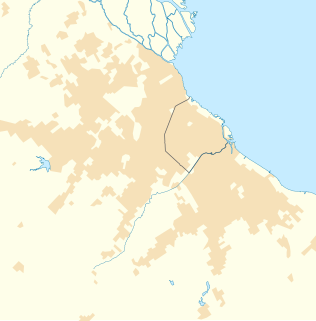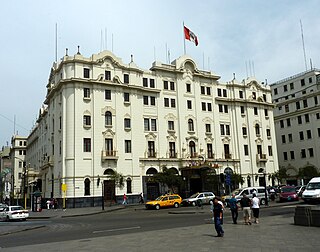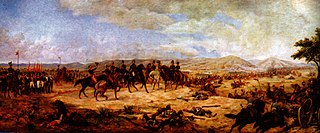
The Viceroyalty of Peru was a Spanish imperial provincial administrative district, created in 1542, that originally contained modern-day Peru and most of Spanish-ruled South America, governed from the capital of Lima. The Viceroyalty of Peru was one of the two Spanish Viceroyalties in the Americas from the sixteenth to the eighteenth centuries.
The Spanish Colonial Revival Style is an architectural stylistic movement arising in the early 20th century based on the Spanish Colonial architecture of the Spanish colonization of the Americas.

Located principally in the city centre or Cercado de Lima and Rímac areas, the Historic Centre of Lima is among the most important tourist destinations in Peru.

Jesús María is one of the most centrally located districts of Lima, Peru. It is a middle-class, high density district and it usually ranks in the top districts with the best quality of life in Lima with an HDI of 0.770 (2005), only behind the districts of San Isidro and Miraflores.

Pueblo Libre is a district of the Lima Province in Peru and one of the districts that comprise the city of Lima. Its name, which means Free Town or Free People, was granted by José de San Martín on April 10, 1822 as a recognition of the patriotism shown by its inhabitants during the Peruvian War of Independence. The district was created by law 9162 on November 5, 1940. The current mayor of Pueblo Libre is Jhonel Leguia and the district's postal code is 21. Pueblo Libre is a middle-class residential community and has the most parks in Lima, although it has several branches of banks, local private universities and major corporations. With a Human Development Index HDI of 0.7667 in 2007, a high level, the same that has increased in recent years. Educational coverage is 98% and service coverage reaches 99.7%.

San Isidro is a municipality in Greater Buenos Aires. It is located 27.9 km from the Autonomous City of Buenos Aires (CABA). It ranks as the province's most affluent neighborhood.

The Jiron de la Union, or the Jiron of the Union, is a pedestrian street located in the Historic Centre of Lima, part of the capital of Peru. For many decades it was the most important boulevards of the city, often described as the most aristocratic, where many of the most affluent citizens of the city and most powerful men around the world would meet. Subsequently, with the deterioration of the centre of Lima, the Jiron de la Union lost its aristocratic character and became completely commercialized.

The Archbishop's Palace of Lima, the capital of Peru, is the residence of the Archbishop of Lima, and the administrative headquarters of the Roman Catholic Archdiocese of Lima. It is located on the Plaza Mayor of Lima, in the Historic Centre of Lima.

The Plaza Mayor or Plaza de Armas of Lima, is the birthplace of the city of Lima, as well as the core of the city. Located in the Historic Centre of Lima, it is surrounded by the Government Palace, Cathedral of Lima, Archbishop's Palace of Lima, the Municipal Palace, and the Palace of the Union.

The Desamparados station is a railway station in Lima, Peru. It is situated on the left margin of the Rímac River, next to the Government Palace. The station was named after the church of Nuestra Señora de los Desamparados. The project began in 1890 by the Peruvian Corporation and three years later the Lima–La Oroya route was inaugurated. The line became known as the Ferrocarril Central Andino

The Gran Hotel Bolívar, is a historic hotel located on Plaza San Martín in Lima, Peru. Designed by noted Peruvian architect Rafael Marquina, it was built in 1924 and was the first large, modern hotel built in Lima.

Escuela Nacional Superior Autónoma de Bellas Artes del Perú (ENSABAP) is a fine arts school in Lima, Peru. It is located in Barrios Altos, a suburb of Lima District. It was founded in 1918, by President José Pardo y Barreda and Peruvian painter Daniel Hernández, who was its first director. It is located in a monumental building built in the early 1940s.

The Protectorate of Peru was a protectorate created in 1821 in modern Peru after its declaration of independence. It existed for a year and 17 days, under the rule of José de San Martín.
José de San Martín is the national hero of Argentina, Chile and Peru, and along with Simón Bolívar, the most important Libertador of the Spanish American Wars of Independence. For this reason, he is homaged and depicted in several cultural works of those countries, and even internationally.

The Historic Centre of Trujillo is the main urban area and the most important center of development and unfolding in the Peruvian city of Trujillo located in La Libertad Region. The whole process of its original urban fabric is in elliptical shape surrounded by España Avenue that was built in the wake of the Wall of Trujillo. It houses the seat of city government and other important entities in the locality. In the center of this historic urban area is the Plaza de Armas of Trujillo that was the scene of the Spanish founded of the city in 1534 and the proclamation of the independence of Trujillo on December 29, 1820.

The Palacio Municipal de Caracas, or Consejo Municipal de Caracas, is the city hall of Caracas, Venezuela. It is located on the corner of Gradillas a Monjas opposite the Plaza Bolívar, occupying half of the plaza's southern section. The building dates from the seventeenth century but now bears the mark of Alejandro Chataing's Neoclassical additions in 1906. It was the focal point for the Constitutional Convention, and signing of the Declaration of Independence in the nineteenth century. The present building is the result of the work undertaken by the Venezuelan architect Alejandro Chataing in 1906. The west wing of the building, the Capilla de Santa Rosa de Lima, the chapel where Venezuela's independence was declared in 1811, has been fully restored and furnished with authentic period pieces. The ground floor houses the Museo Caracas, which contains works by Venezuela's most celebrated painters and many other historic artifacts. It was declared a National Historic Landmark on 16 February 1979.

Victorio Macho was a renowned 20th century Spanish sculptor. He is considered to be one of the greats of modern Spanish sculpture. His style was influenced by art deco. His home and workshop in Toledo was converted into a museum dedicated to his work, the Victorio Macho Museum, after his death. He has been featured on a postage stamp of Spain.

The Plaza Bolivar is a square in Valencia, Venezuela. It occupies a central site, and is used for public meetings. Its origin was in the colonial period, when the city was laid out on a grid plan.(see note) The square was renamed after Simón Bolívar in the 19th century. Some buildings in the vicinity, such as the Cathedral date from the colonial period, but the square is noted for a monumental column celebrating Venezuela´s independence. Inaugurated in 1889, the column commemorates Bolívar and the battle of Carabobo (1821).



























